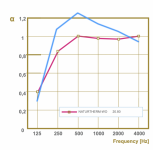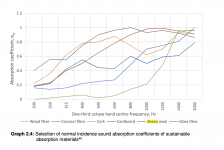Unfortunately Materiaux Naturels won't ship to Italy (at least not for the small amount I am buying) so the search continues...
Check out Basotect, works great.
Here are some measurements of different damping materials, see also the previous pages for more detailed measurements.
Google translate can help if German is not that understandable.
There's the shop EWOS in Italy that sells all kind of damping materials and also Basotect panels.
Basotect is easy to cut with a cutter.
Here are some measurements of different damping materials, see also the previous pages for more detailed measurements.
Google translate can help if German is not that understandable.
There's the shop EWOS in Italy that sells all kind of damping materials and also Basotect panels.
Basotect is easy to cut with a cutter.
Last edited:
I hope the gardener is delivered with the moss for the price because the maintenance does not seem so easy 😀
There's the shop EWOS in Italy that sells all kind of damping materials and also Basotect panels.
Thanks for the link!
@Pano
I think the name that escaped you also frequently escapes me: Tectum
TECTUM Direct-Attach Wall Panels | Armstrong Ceiling Solutions – Commercial
I love Tectum, have used many square feet. Has the special virtue of not losing as much effect at low notes, as compared to other stuff.
No one has mentioned the cleanest material: air. For example, Tectum (and any of the boards) can be mounted with air space behind, esp if you "plaster" your walls with it as replacement for drywall sheets.
Air also relates to the "membrane" absorbers, like with lots of holes (based on calculation) like an ancient Bell phone booth (hooray for Bell Labs).
Also something I mention often is the fact that the Sabine value of a room is the total of all the absorbent everywhere - open closets, under the couch*, behind the bookcase, not just stuff conventionally thought of as acoustic control.
B.
* a lot of modern couches - like Ikea stuff - are all but transparent to sound.
"...not just stuff conventionally thought of as acoustic control."
Like the human occupants.
Manage the sound by adjusting your guest lists.
Like the human occupants.
Manage the sound by adjusting your guest lists.
I have been also interested in alternative material to Owens Corning 703, but I can't still find anything that matches to the sound absorption coefficients that 703 offers. Not even close...
What's the figure of merit that you're looking for?
https://www.bobgolds.com/AbsorptionCoefficients.htm
https://www.bobgolds.com/AbsorptionCoefficients.htm
Cotton and wool don't match or better Corning 703?
Comparing the 80mm thick wool batt which I'm looking at (in red) with 76mm thick 703 (in blue), the 703 does come out ahead above 150Hz. However, the wool measurements are using UNI EN ISO 354 whereas the 703 measurements use "ASTM C423; Mounting: Type A–Material placed against a solid backing". I have no idea whether these standards produce comparable results. This wool is only 20kg/m3 which is not particularly dense so perhaps a higher density would increase performance.

I could also simply use more sheep's wool to match the performance of 703 but thin panels are much more appealing in domestic rooms. I would like my panels to be barely noticeable.
Last edited:
I found this chart in "The acoustic performance of suspended ceiling systems" by George van Hout. Interesting to see how well wood fibre performs, though it sounds like a potential fire hazard (and adding flame retardant material defeats the purpose of looking for natural materials). Sheep wool comes in third:


Last edited:
Interesting chart, thanks.  Is it the cardboard that does so well?
Is it the cardboard that does so well?
Just looking at spec sheets I've always seen that the denim is very close to fiberglass panels and rockwool across much of the spectrum, but somewhat better in the low end. Hard to say, but it has worked well for me inside speakers. I haven't used it much on walls.
 Is it the cardboard that does so well?
Is it the cardboard that does so well?Just looking at spec sheets I've always seen that the denim is very close to fiberglass panels and rockwool across much of the spectrum, but somewhat better in the low end. Hard to say, but it has worked well for me inside speakers. I haven't used it much on walls.
Like the human occupants.
Manage the sound by adjusting your guest lists.
A more astute comment than you may have thought.
In designing concert halls, effort is made to select seating that has the same acoustic properties with and without patrons in the seats.
Anybody have the curve for Tectum? Really hard to get control below 200 Hz, yet that's where we need control.
B.
Yes, always astute.Of course, I just might be astute. ;-)
Thanks for Tectum data. While so-so in absorption (it is just shredded wood fibers), the frequency response is flatter... and that may be a primary factor in acoustic design for a music room, not HF control. So you can use more Tectum and get better results and flatter tone compass.
Not always straightforward reading data (esp from commercial sources). While Tectum sheets may look so-so, their normal mounting is like drywall (since they are strong panels), with a few inches behind while other panels lay flat on the walls. So a 2-inch comparison may not be quite illustrative.
For sure, expensive multi-layer petrochemical foams can outperform low-tech materials. I have lined furnace ducts with that expensive stuff... esp with heavy-metal barrier layers.
BTW, Tectum is very durable (stuff I have in storage seems unlike new after 40 yrs) while petro-chemical foams may last no longer than foam surrounds on drivers, DAMHIK.
B.
Last edited:
LOL Astute. Yeah, that's what she said last night (or I might have misheard...)
My dad was in an AE office and when I visited the office or went on inspections as a little kid seeing Tectum in the sample room and installed in some of the buildings they designed was oddly memorable. It was a cool material. We still have some pieces kicking around the house and you're right... it's durable!
Where did you buy your Tectum? My brother was looking for some just the other day but I never had to find an outlet when my dad was working.
My dad was in an AE office and when I visited the office or went on inspections as a little kid seeing Tectum in the sample room and installed in some of the buildings they designed was oddly memorable. It was a cool material. We still have some pieces kicking around the house and you're right... it's durable!
Where did you buy your Tectum? My brother was looking for some just the other day but I never had to find an outlet when my dad was working.
....Where did you buy your Tectum?....
Can't remember, but maybe a traditional lumber yard (before you-know-who drove them out of business) and maybe on special order.
I don't remember seeing Tectum anywhere but public buildings. Never is studios or homes - has anyone? It certainly seems to work well where I've heard it.
At one time I was looking at acoustic ceiling tiles. Cheap and easy, but maybe not too effective. I built my own panels with fiberglass and was happy.
At one time I was looking at acoustic ceiling tiles. Cheap and easy, but maybe not too effective. I built my own panels with fiberglass and was happy.
That site has a nice comparison graph of Rockwool, melamine(Basotect), Tectum, ...
The Basotect graph corresponds with the findings of Gaga in diy-hifi-forum.eu (2nd graph)
Attachments
- Home
- General Interest
- Room Acoustics & Mods
- Healthy alternatives to foam or rock/glass wool

